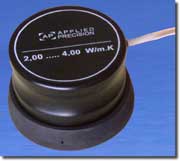열전도도측정기 (열선법)
QUICKLINE™-30
특징
본 제품은 Hot wire method의 한 형태로써 시편에 삽입된 probe (hypodermic needle) 또는 편평한 시편에 접촉시키는 surface probe의 반응으로 부터 열전도도를 측정하는 Probe Method 로써, 분말이나 반고체 시료(semirigid form) 중 열전도성이 낮은 물질에 매우 편리하게 쓰일 수 있으며 성능대비 경제적인 기기입니다.
온도범위 / 측정범위
-15°C ~ 50°C ... Operational temperature
0.015 - 6.0 W/mK (depending on probes) ... 열전도도 측정범위
▣ 열전도도(λ), 열확산율(α), 비열(volume heat capacity, Cp), 온도 (T) 측정
▣ 현장 사용이 가능한 저가의 portable 겸 desktop 열물성측정기
▣ 측정시간이 빠르다.
▣ 다양한 Surface probe 및 Needle probe
▣ Ideal for plastics, foams, and geological use
▣ Volume heat capacity: 4.0 x 10 4 - 4.0 x 10 6 J/m 3 K Relatively recent modification of a long-established Hot Wire Method is the “probe“ method. This configuration is particularly practical where the specimen conductivity is determined from the response of a “hypodermic needle” probe inserted in the test specimen. Thus the method is conveniently applied to low-conductivity materials in powder or other semirigid form. A probe device can be used to measure the thermal properties of soils in situ, but most commonly a closely controlled furnace is used to contain the sample and produce the base temperatures for the tests. The probe contains a heater and a thermocouple attached to it. When a certain amount of current is passed through the heater for a short period of time, the temperature history of the heater's surface will take on a characteristic form. In the initial phase, the temperature will rapidly rise, and as the heat begins to soak in, the rate of rise becomes constant. When the thermal front reaches the outer boundary of the sample, the rise will slow down or stop altogether due to losses into the environment. From the straight portion of the rate curve (temperature vs. time) the thermal conductivity can be calculated. *1)

|
본 제품은 재료의 열전도도(thermal conductivity, λ ), 열확산율 (thermal diffusivity, α ), 온도, 체적비열 (volume heat capacity, Cp)을 상온에서 신속하게 측정하는 포터블 겸 데스크탑 겸용 열물성측정기로써 다공성 재료, 섬유질, 연한 재료의 측정을 위한 needle probe와 단단한 재료의 측정용 surface probe를 선택적으로 장착 사용하는 기기이다.
QUICKLINE™-30 이용 시 dynamic method를 加하기 때문에 열전도도측정 시간을 10분 ~ 16분까지 줄여 준다. 메뉴관리가 4-line alphanumeric display상에 표시되므로 기기의 interactive comminication과 표준물질에 의한 측정 probe의 보정이 효율적이다.
Calibration data가 internal memory에 기억되어 있기 때문에 probe를 교체하여도 측정의 정확성에는 아무런 영향을 주지 않는다. 측정 데이터는 internal memory에 저장되며 메모리에 저장된 내용은 display나 RS 232 serial interface로 PC에 전송해서 읽을 수 있다.
|
DESCRIPTION
• 저렴한 측정기이며,
• 측정속도가 빠르다.
• 현장에서 사용이 가능한 포터블 형
• 다양한 형태의 probe (surface or needle probes) 선택 측정
• 플라스틱과 발포체, 지질의 열전도도측정에 용이하다.
• ASTM D5930, D5334 등재
Measured Quantities
λ - Thermal Conductivity, W/mK
α - Thermal Diffusivity, m²/s
Cp - Volume Heat Capacity, J/m³K
T - Temperature, °C
|
토목공학
• 건축재료의 열물성 분석
• 단열재 개발의 최적화
• 건물이나 파이프라인 등의 단열 검사
지질학적 측정
• 토양이나 모래, 바위의 열물성 분석
• 토양의 균질성 검사
화학 산업
• 화학물질 및 화학첨가제, 윤활유, 플라스틱, 현탁물질, 고무, 발포체 등의 열물성 분석
목재 산업
• 목재의 열물성 분석
• 수분 측정 및 건조 공정 최적화
섬유 산업
• 섬유의 열접촉 안정성 최적화
• 섬유의 합성 및 surface adjustment
• 바닥 타일 및 카페트 평가

- Broad Lambda range specification
- Hard rocks, liquids, suspensions, soft foam 등
기계적 특성이 다른 다양한 재료 측정
- 사용자가 원하는 사양의 probe 한 개가 기본으로 공급된다.
 |






